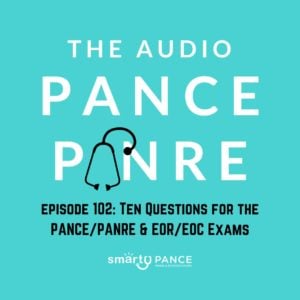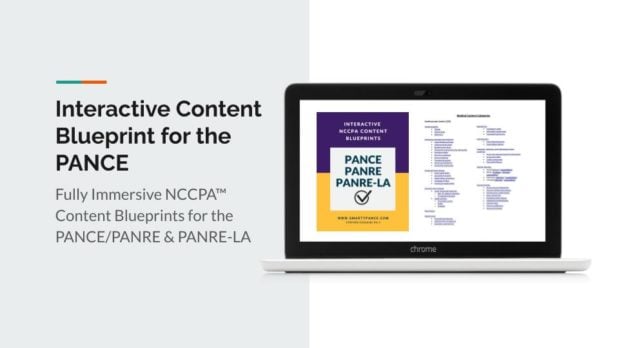Podcast: Play in new window | Download
Subscribe: Apple Podcasts | RSS
Listen to Podcast Episode 102: Ten PANCE, PANRE, and Rotation Review Questions
If you can’t see the audio player, click here to listen to the full episode.
 Welcome to episode 102 of the Audio PANCE and PANRE Physician Assistant/Associate Board Review Podcast.
Welcome to episode 102 of the Audio PANCE and PANRE Physician Assistant/Associate Board Review Podcast.
Join me today as we cover ten board review questions for your PANCE, PANRE, EOR™, and EOC™ exams.
Special from today’s episode:
- Read The New 2023 PANRE and PANRE-LA: Everything you Need to Know
- Members can try out the newly updated PANRE-LA Smart Search (you must log in to access the search bar)
- Sign up for the Entire Blueprint Email Series
- Follow Smarty PANCE and The Daily PANCE Blueprint on Instagram
- Follow Smarty PANCE and The Daily PANCE Blueprint on Facebook
- Join the Smarty PANCE Member’s Community then sign up for a study group to get updates about upcoming webinars.
I hope you enjoy this free audio component of the examination portion of this site. Smarty PANCE includes over 2,000 interactive board review questions, along with flashcards, ReelDx cases, integrated Picmonics, and lessons covering every blueprint topic available to all Smarty PANCE members.
- You can download and listen to past FREE episodes here, on iTunes, Spotify, Google Podcasts, Stitcher, and most podcasting apps.
- You can listen to all the latest episodes, take interactive quizzes, and download more resources on each episode page.
Interactive exam to complement today’s podcast
1. Which of the following is NOT true about a non-ST elevation myocardial infarction?
A. Non-enteric-coated, chewable aspirin 325 mg should be given
B. Troponins are elevated
C. It happens due to a partially occluded epicardial coronary artery
D. Patients need a 12-lead EKG
E. You will always see ST depressions
2. A 22-year-old G1P0 female at 28 weeks gestation with a history of diabetes presents to the clinic with fever, chills, and dysuria. Vitals show tachycardia (115 bpm), tachypnea (22 bpm), and hypotension (90/58 mmHg). Physical exam reveals suprapubic tenderness. Labs reveal leukocytosis, hyponatremia, and hyperglycemia. Urine dipstick is positive for nitrites, blood, glucose, and ketones. Which of the following is the next best step?
A. Send home with oral antibiotics and analgesics
B. Reassurance and oral rehydration solution
C. Admit to hospital for antibiotics, fluids, & insulin
D. Order outpatient CT scan of the abdomen
E. Refer to an outpatient nephrologist for workup
3. Which of the following is the most common benign neoplasm of the liver?
A. Hepatocellular carcinoma
B. Hepatic hemangioma
C. Liver angiosarcoma
D. Hepatocellular adenoma
E. Hepatoblastoma
4. A 12-year-old male presents with a sore throat, fever, dysphagia, and a muffled voice. On physical exam, the uvula is deviated. Which of the following is the most likely diagnosis?
A. Pharyngitis only
B. Retropharyngeal abscess
C. Peritonsillar abscess
D. Oral candidiasis
E. Foreign body
5. Which of the following is the most common cause of acute epiglottitis?
A. Staphylococcus aureus
B. Haemophilus influenzae
C. Streptococcus pneumoniae
D. Streptococcus pyogenes
E. Neisseria meningitidis
6. A 32-year-old female presents with pain around the nail fold on the index finger of her right hand. She is afebrile. On physical exam, you appreciate erythema and swelling of the proximal nail fold. The area is not fluctuant. Which of the following is the best treatment option?
A. Topical antibiotics and warm water soaks
B. Intravenous antibiotics
C. Oral antibiotics and incision and drainage
D. Surgical consult for removal
E. None of the above
7. A 60-year-old male presents with fatigue and weight loss. His physical exam is remarkable for gingival hyperplasia and splenomegaly. Labs reveal pancytopenia. A bone marrow biopsy reveals Auer rods. What is the likely diagnosis?
A. Acute myeloid leukemia
B. Acute lymphocytic leukemia
C. Chronic myeloid leukemia
D. Chronic lymphocytic leukemia
E. Non-Hodgkin’s lymphoma
8. A 42-year-old female presents for an annual physical exam with some complaints of fatigue and dyspnea. On physical exam, you appreciate a fixed S2 split. Which of the following is the most likely diagnosis?
A. Ventricular septal defect
B. Mitral regurgitation
C. Aortic stenosis
D. Atrial septal defect
E. Patent ductus arteriosus
9. Which of the following is not a test for acute appendicitis?
A. Murphy sign
B. Rovsing sign
C. Obturator sign
D. Psoas sign
E. McBurney sign
10. A 31-year-old female presents with pain and numbness in her anterior tibial region. On physical exam, the area is pale, cold, and pulseless. Which of the following is the best definitive treatment for this likely diagnosis?
A. Antiplatelets
B. Amputation
C. Physical therapy
D. Fasciotomy
E. IV heparin drip
This podcast is available on every device!
You can download and listen to past FREE episodes here, on iTunes, Spotify, Google Podcasts, Stitcher, Amazon Music, and all podcasting apps.
Download Interactive Content Blueprint Checklists for the PANCE, PANRE, EOR, and PANRE-LA
Follow this link to download your FREE copy of the PANCE/PANRE/EOR Content Blueprint Checklists.
Print it up and start crossing out the topics you understand, marking the ones you don’t, and making notes of key terms you should remember. The PDF version is interactive and linked directly to the individual lessons on Smarty PANCE.

